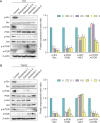Dasatinib induces apoptosis and autophagy by suppressing the PI3K/Akt/mTOR pathway in bladder cancer cells
- PMID: 39505519
- PMCID: PMC11543652
- DOI: 10.4111/icu.20240250
Dasatinib induces apoptosis and autophagy by suppressing the PI3K/Akt/mTOR pathway in bladder cancer cells
Abstract
Purpose: Bladder cancer is a common genitourinary malignant disease worldwide. Dasatinib is a small molecule inhibitor of Src family kinases. We investigated the anticancer effect and putative molecular mechanisms of dasatinib on T24 and cisplatin-resistant T24R2 human bladder cancer cells.
Materials and methods: Cell proliferation was measured using Cell Counting Kit-8 (CCK-8) and colony formation in dasatinib treated bladder cancer cells. Flow cytometry was used to determined cell cycle arrest and apoptosis. The expression of apoptosis and autophagy related proteins were detected by western blot analysis.
Results: In bladder cancer cells, dasatinib significantly reduced cell proliferation, colony formation, and induced G1-phase arrest. Dasatinib triggered apoptosis along with an increased expression of apoptosis-related genes (caspases, PARP, and cytochrome c). Down-regulation of Bcl-2 and up-regulation of Bad, which are hallmarks of apoptosis, were found to play a dominant role in mediating the effects of dasatinib treatment. We further showed that dasatinib inhibits p-Src, p-PI3K, p-Akt, and p-mTOR in bladder cancer cells. Dasatinib also increased the expression of markers of autophagy flux such as LC3-II and p62.
Conclusions: These results confirmed that dasatinib is a potent chemotherapeutic drug which induces apoptosis and autophagy by suppressing the PI3K/Akt/mTOR pathway in bladder cancer cells.
Keywords: Anticancer; Apoptosis; Autophagy; Bladder cancer; Dasatinib.
© The Korean Urological Association.
Conflict of interest statement
The authors have nothing to disclose.
Figures








References
MeSH terms
Substances
Grants and funding
LinkOut - more resources
Full Text Sources
Medical
Research Materials
Miscellaneous

